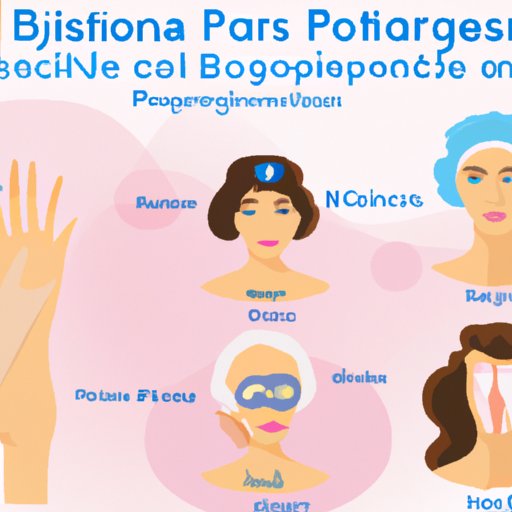Introduction
Plastic surgery is a medical specialty that focuses on the reconstruction and alteration of the body’s form and appearance. It can be used to treat a variety of conditions, including birth defects, trauma injuries, skin discoloration, and other deformities. There are two main types of plastic surgery: reconstructive surgery, which is used to correct physical deformities; and cosmetic surgery, which is used to enhance a person’s appearance.
In this article, we will explore the different types of plastic surgery and how they work, investigate the pros and cons of plastic surgery, examine the risks involved in plastic surgery, discuss the techniques used in plastic surgery, look at recovery times for plastic surgery procedures, and conclude with some final thoughts.

Exploring the Different Types of Plastic Surgery and How They Work
The most common types of plastic surgery include facelifts, breast augmentation, liposuction, rhinoplasty, and abdominoplasty. Let’s take a closer look at each one.
Facelifts
A facelift, or rhytidectomy, is a surgical procedure that is used to reduce the signs of aging by tightening the facial muscles, removing excess skin, and smoothing out wrinkles. The procedure typically takes two to four hours and is done under general anesthesia. After the procedure, patients can expect swelling, bruising, and discomfort, which can last for several weeks.
Breast Augmentation
Breast augmentation, or augmentation mammoplasty, is a surgical procedure that is used to increase the size, shape, and symmetry of the breasts. The procedure can involve implants or fat transfer and usually takes about two hours. Patients can expect soreness, swelling, and possible scarring after the procedure.
Liposuction
Liposuction, or lipoplasty, is a surgical procedure that is used to remove excess fat from specific areas of the body. The procedure typically takes one to two hours and is done under general anesthesia. After the procedure, patients can expect swelling, bruising, and discomfort, which can last for several weeks.
Rhinoplasty
Rhinoplasty, or nose reshaping, is a surgical procedure that is used to reshape the nose. The procedure typically takes two to three hours and is done under general anesthesia. After the procedure, patients can expect swelling, bruising, and discomfort, which can last for several weeks.
Abdominoplasty
Abdominoplasty, or a tummy tuck, is a surgical procedure that is used to remove excess skin and fat from the abdomen. The procedure typically takes one to three hours and is done under general anesthesia. After the procedure, patients can expect swelling, bruising, and discomfort, which can last for several weeks.

Investigating the Pros and Cons of Plastic Surgery
Plastic surgery has its advantages and disadvantages. Let’s take a look at both.
Advantages of Plastic Surgery
One of the biggest advantages of plastic surgery is that it can improve a person’s self-esteem and confidence. Plastic surgery can also be used to correct physical deformities and help people achieve their desired look. Additionally, it can be used to improve a person’s health and quality of life.
Disadvantages of Plastic Surgery
One of the biggest disadvantages of plastic surgery is that it is an expensive and risky procedure. Additionally, there is no guarantee that the results will be what the patient expects or desires. Finally, some people may experience psychological issues such as depression or body dysmorphia after undergoing plastic surgery.
Examining the Risks Involved in Plastic Surgery
As with any surgical procedure, there are risks associated with plastic surgery. Let’s take a look at the general risks associated with plastic surgery, as well as the specific risks associated with each type of plastic surgery.
General Risks Associated with Plastic Surgery
General risks associated with plastic surgery include infection, excessive bleeding, nerve damage, allergic reactions, scarring, and asymmetry. Additionally, some plastic surgery procedures can cause complications such as blood clots, organ damage, and heart attack.
Specific Risks Associated with Each Type of Plastic Surgery
Facelifts can cause nerve damage, infection, and scarring. Breast augmentation can cause infections, implant rupture, and capsular contracture. Liposuction can cause nerve damage, infection, and skin irregularities. Rhinoplasty can cause infection, breathing problems, and permanent numbness. Abdominoplasty can cause infection, fluid accumulation, and abdominal wall weakness.

Discussing the Techniques Used in Plastic Surgery
Plastic surgery involves a variety of techniques, both surgical and non-surgical. Let’s take a look at the techniques used in plastic surgery.
Surgical Techniques Used in Plastic Surgery
The most common surgical techniques used in plastic surgery include excision, grafting, flaps, and tissue expansion. Excision is the process of cutting away excess skin or tissue. Grafting is the process of taking healthy skin or tissue from one area of the body and transplanting it to another area. Flaps involve moving tissue from one area of the body to another. Tissue expansion is a technique used to stretch the skin in order to create more skin for grafting.
Non-Surgical Techniques Used in Plastic Surgery
Non-surgical techniques used in plastic surgery include laser resurfacing, chemical peels, and injectables. Laser resurfacing is used to reduce wrinkles and scars. Chemical peels are used to remove the outer layers of the skin. Injectables are used to fill in wrinkles and add volume to the face.
Looking at Recovery Times for Plastic Surgery Procedures
Recovery time varies depending on the procedure and the individual patient. Let’s take a look at some factors that affect recovery times, as well as the average recovery times for different plastic surgery procedures.
Factors That Affect Recovery Times
Factors that affect recovery times include the type of procedure, the extent of the procedure, the age and health of the patient, and the patient’s ability to follow post-operative instructions. Additionally, smoking can slow down the healing process.
Average Recovery Times for Different Plastic Surgery Procedures
The average recovery time for a facelift is two to four weeks. The average recovery time for a breast augmentation is two to six weeks. The average recovery time for liposuction is two to four weeks. The average recovery time for a rhinoplasty is two to four weeks. The average recovery time for an abdominoplasty is two to four weeks.
Conclusion
Plastic surgery is a medical specialty that can be used to treat a variety of conditions and enhance a person’s appearance. There are many different types of plastic surgery, each with its own set of risks and recovery times. It is important to understand the risks and make sure you are physically and mentally prepared for the procedure before deciding to have plastic surgery.
(Note: Is this article not meeting your expectations? Do you have knowledge or insights to share? Unlock new opportunities and expand your reach by joining our authors team. Click Registration to join us and share your expertise with our readers.)
